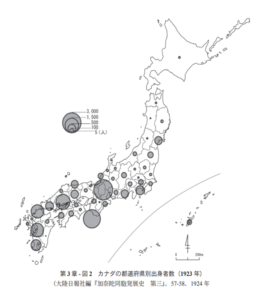From Mio: Rediscovering Japanese Canadian Transpacific Historiographies for Glocal Community Building

A Community-Based Participatory Action Research Project on Pre-World War 2 Migration between Mio, Wakayama (America-mura), Japan and Vancouver Island, BC, Canada
Lisa Domae 堂前 リサ, Ph.D., MCIP, North Island College, British Columbia, Canada
河上幸子 Sachiko Kawakami, Ph.D., Kyoto University of Foreign Studies, Kyoto, Japan
To support place-based roots and historical tourism and the ongoing reconstruction of the Japanese Canadian community, the purpose of this bilingual, multi-sector, Canada-Japan research program is to use a community-based participatory action-research (CBPR) framework to document for public and academic audiences, the historiographies of the first migrants (Issei) from Mio, Wakayama to Vancouver Island, British Columbia, Canada. CBPR is a transformative “partnership approach to research that equitably involves community members, organization representatives, and researchers in all aspects of the research process”.1 Taking a transpacific perspective that is conducted synonymously in English and Japanese and in partnership with community members, organizations, and higher education institutions, ‘From Mio’ will directly enrich Japanese Canadians while engaging with and contributing to small rural communities’ efforts to animate their histories and vitalize themselves based on roots and historical tourism.
Mio, Wakayama, an isolated village of 1,2212 people in the late 1800s was one of the largest single sources of pre-World War 2 Japanese migrants to Canada. By 1939, over 3000 Japanese Canadians could directly trace their roots to Mio. 2014 estimates suggest that number now exceeds 10,000, comprising 10% of Canada’s Japanese Canadian population.3 The migration of most of the adult male labour force to coastal British Columbia economically, physically and socially transformed Mio, which became known as America-mura (America village) as a result. 4 The trans-pacific story of Mio’s transformation from the “harbor to return home to” to the “mother village where one explores one’s roots” has not been fully told.5 Having disembarked in Victoria, many Issei settled in small resource-rich communities on Vancouver Island while maintaining connections with the larger ethnic enclave that was Steveston. While the historiographies of Japanese migration between Mio and Steveston have been well chronicled, the story of pre-war Japanese migration to and from Canada is also profoundly rural, reflecting the mobility patterns of economic migrants pursuing wealth in the fishing industry and shifting to forestry, mining and farming seasonally and as a result of fishing license restrictions.
The dynamic between Mio, Wakayama and rural Vancouver Island locales remains largely unexplored.6 3,400 Nikkei lived on Vancouver Island in 1941 when World War 2 began.7 Wakayama originating settlements across Vancouver Island were devastated by the internment of every coastal Japanese Canadian during World War 2. Community-based organizations have collected, preserved and restored records, artefacts and landscapes that internees left behind. Their work deserves animation and public attention. Connecting and documenting these resources for the Japanese Canadian community and for the academic record is also long overdue.
‘From Mio’ brings together a diverse group of transpacific stakeholders in a collaboration that will: ∑ examine and document pre-war Japanese migration between Mio and Vancouver Island ∑ examine and document the long-term impact of emigration on the village of Mio and the receiving communities ∑ document the post-war and place-based preservation and rehabilitation of records, artefacts and landscapes from these communities
∑ examine and document the experiences of Japanese Canadians and Japanese in search of their family roots in Japan and Canada and develop a model for Vancouver Island Nikkei tourism.
1 Israel, B. (2013). Methods for Community-based Participatory Research for Health. San Francisco: Jossey-Bass.
2 Adachi, K. (1976). The Enemy That Never Was: The History of the Japanese Canadians. Toronto, Ontario: McClelland and Stewart. p. 18 3 Nishihama, H. (2014). アメリカ村 (Amerikamura). Retrieved from http://jacs.jp/dictionary/dictionary-a/09/19/462/
4 Fukawa, M., Fukawa, S., & Committee, N.F.S.H.B. (2009). Spirit of the Nikkei Fleet: BC’s Japanese Canadian Fishermen. Vancouver, BC: Harbour Publishing. 5 Nishihama, H. (1993). Kanada no Imin no Chichi Kuno Gihei. Ijyu Kenkyu, 30, 170-184.
6 Kawahara, N. (2018). Perspectives and Issues Concerning Research of Japanese Fisheries History in Canada (In Japanese), Ritsumeikan Bungaku (The Journal of Cultural Sciences) 656:121-135.
7 Takata, T. (1996). Foreword. In C. Lang (Ed.), O-Bon in Chimunesu: A Community Remembered (pp. 9-18): Arsenal Pulp Press.
Number of people from each province in Canada
